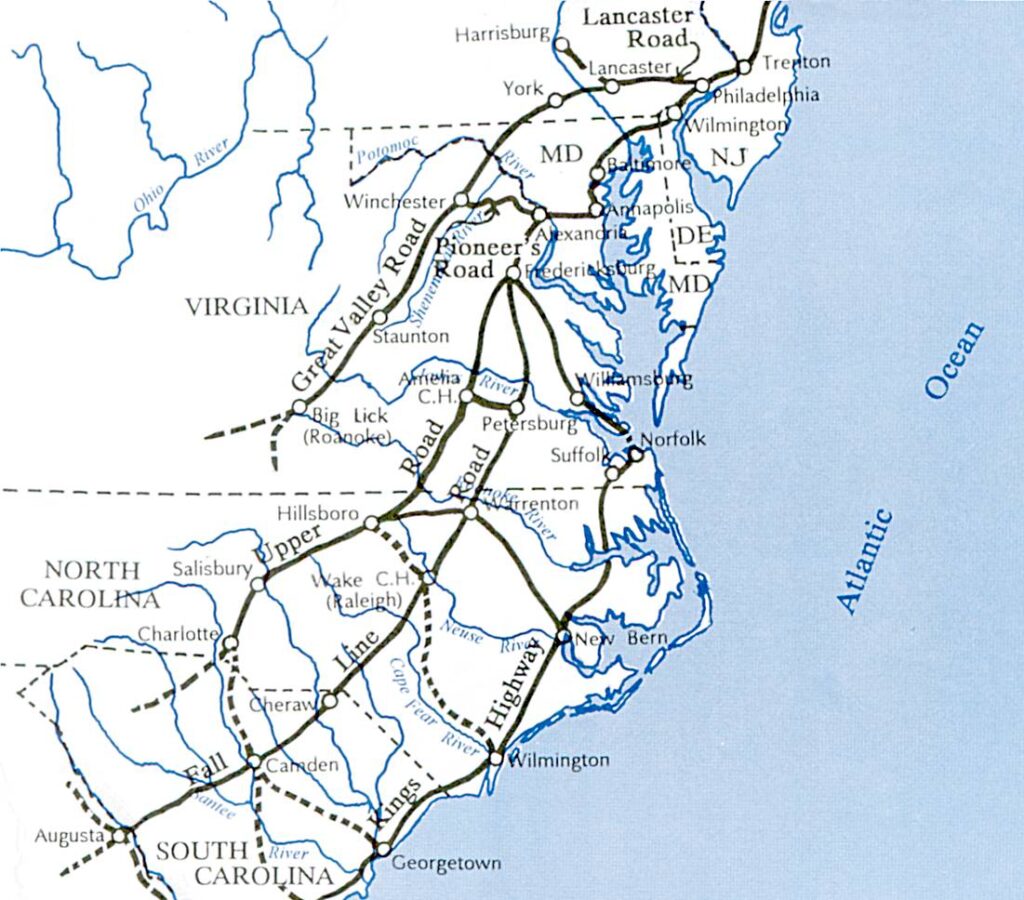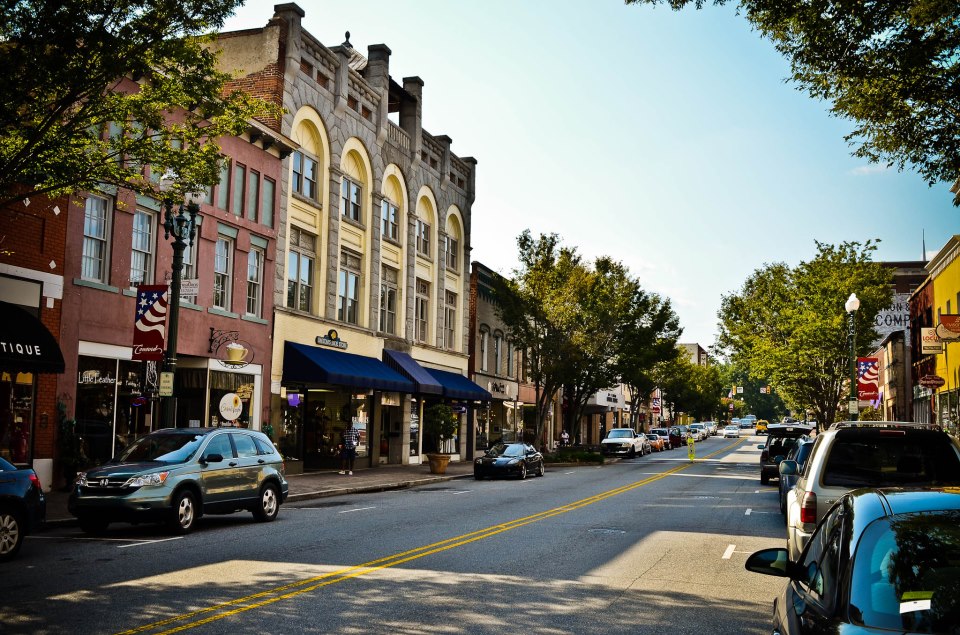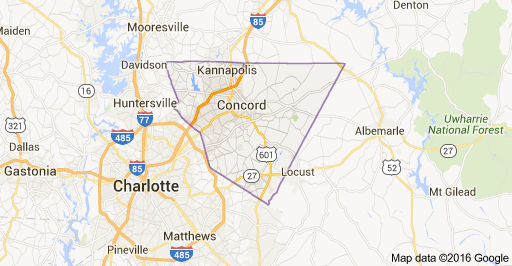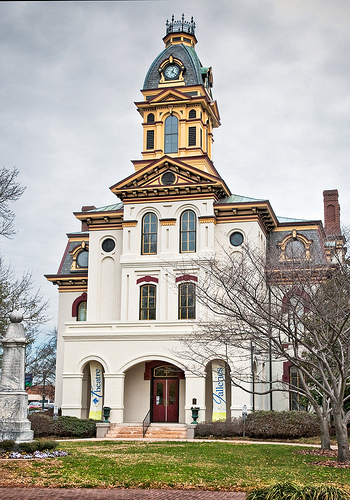Images of Cabarrus County Wills and Estates
The Great Wagon Road
The great wagon road led many pioneers out of eastern Pennsylvania (Lancaster and York) and northeastern Maryland into North Carolina. Groups of lowland Scots from Ulster in Northern Ireland and German Lutherans who had arrived at the Port of Philadelphia traveled along that road. The road crossed the Potomac River and entered the Shenandoah Valley near Martinsburg, West Virginia and continued south through the valley on the Great Warriors Trail (Indian Road) used by Indians for many years. The Treaty of Lancaster in 1744 established the rights of the colonists to settle along Indian Road. After the French and Indian War (1756-1763) it was the most heavily traveled road in America. It is generally accepted that these first Scotch/Irish settlers claimed the richer “black jack” lands of western and southern Cabarrus County, so that German settlers arriving in the 1740s claimed lands on both sides of Dutch Buffalo Creek. To their west, along Cold Water Creek, lived a colony of Welsh/English, who brought their Baptist religious traditions with them. Later on, the colonial churches were Lutheran and Presbyterian took root.


Names of Families in Cabarrus County Wills and Estates
Cabarrus county was formed from Mecklenburg County in 1792, and was named after Stephen Cabarrus of Chowan County, Speaker of the North Carolina House of Commons. Conrad Reed found gold here in 1799 while playing in Little Meadow Creek on the old Reed farm. His find weighed a hefty 17 pounds! John Reed or Johannes Rieth as he was known in Staatsarchiv at Marburg, Germany was one of thousands of Hessian soldiers transported over by British troops to fight against rebellious colonists during the Revolutionary War. John Reed deserted, as did many other Hessians, and migrated from Georgia to North Carolina, where he settled in an ethnic German community sometime around 1787. Reed developed placer mining, then underground mining on his property and became wealthy, his mine being known as the Reed Gold Mine. The Reed Gold Mine was designated as a National Historic Landmark. The names of the testators in the last will and testaments below appear to be of German origin, undoubtably descendants of the Hessian soldiers.
Transcripts of Cabarrus County Wills 1796 to 1822
| Abendshein, Catherina | Abendshein, Christian | Abendshein, Rinehold | Dayvault, Jacob |
| Hadley, James and Joshua | Hagler, John | Hall, John | Hall, Morgan |
| Harky, George | Harris, Charles, Dr. | Harris, Elizabeth | Harris, Ephraim |
| Harris, James | Harris, Robert Sr. | Harris, Robert | Harris, William |
| Hartman, George | Hill, Green | Hope, Robert | Horlacher, Christopher |
| Houston, Archibald | Houston, John | Houston, Margaret | Hudson, Fanny |
| Hudson, Seth. | Huie, Samuel | Marchadant, John. | McCaleb, James |
| McClellan, Thomas | McCommon, Charles | McCree, Hugh | McMahan, John |
| McRee, Richard | McCree, William | McEwen, Elizabeth | McFaddon, Thomas |
| McGinnis, Charles | McGraw, Benjamin | McGraw, James | McKinley, Charles |
| McKinley, John | McLarty, Archibald | McMakin, James | McRee, David |
| McMurrey, Robert | Mealor, Peter | Melchor, John | Meissenheimer, Jacob |
| Misenheimer, Abraham | Misenheimer, George Sr. | Misenheimer, Jacob. | Mitchler, Matthias |
| Morris, Griffith | Morris, Griffith | Morris, Moses | Morris, Samuel |
| Morris, Nancy | Morris, Nancy | Morton,, Samuel | Phifer, George |
| Query, Alexander | Strickler, Daniel | Wagoner, Will | Walcher, Adam |
| Walker, Andrew | Wallace, Aaron | Wallace, James | Wallace, John |
| Wallace, William | Watson, Thomas | Welch, Elizabeth | Wessner, George |
| White, Archibald | White, David | White, Jean | White, John |
| White, John | White, Margaret | White, Mary | White, Samuel |
| White, William | Wilhelm, George | Wilie, Mary | Wiser, Michael |
| Wiser, Phillip | Wynkaugh, Michael | Yonge, Catherine | Young, Joseph |
| Young, William |

